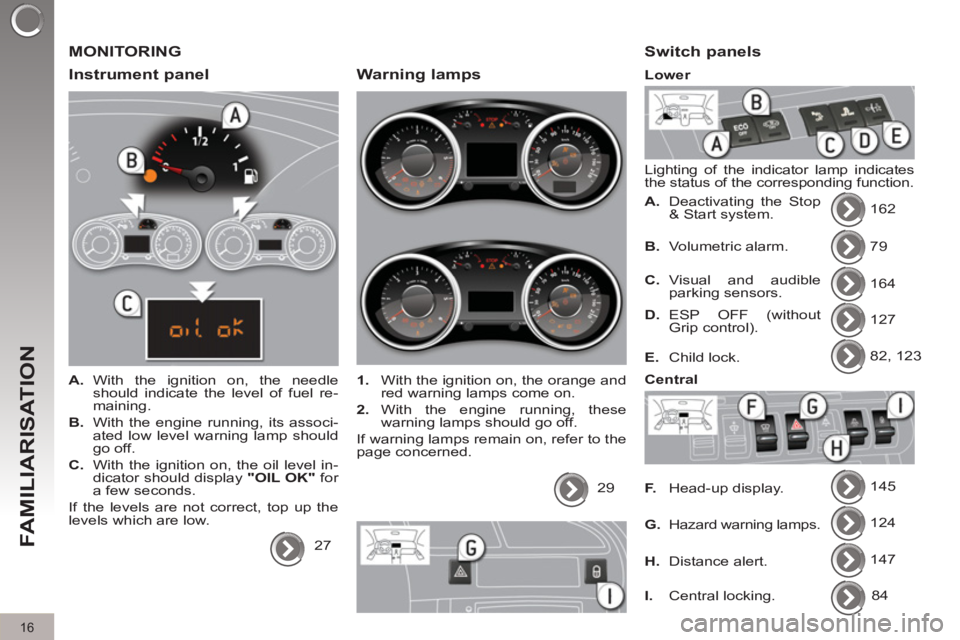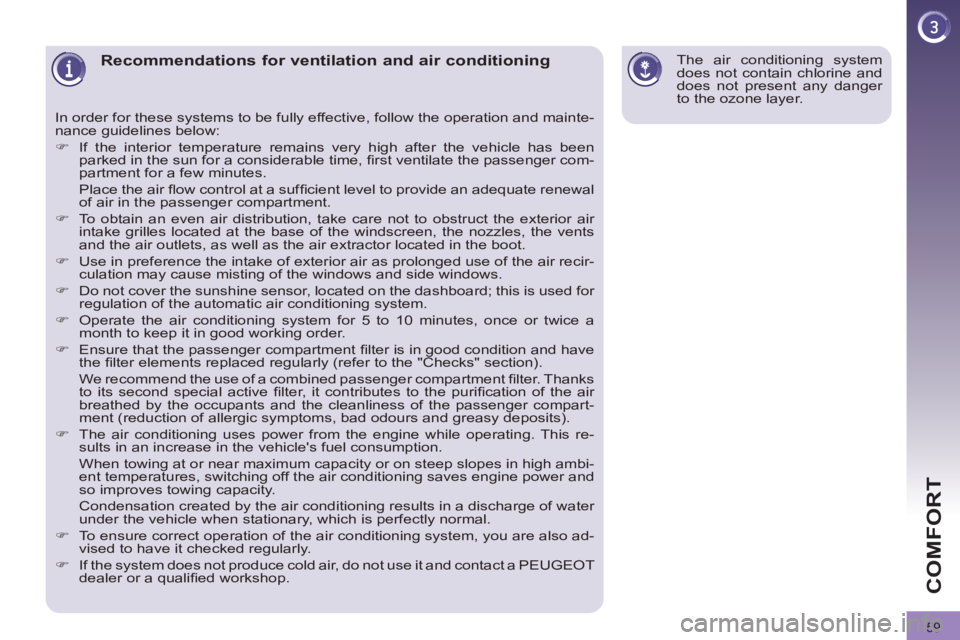2012 PEUGEOT 308 sensor
[x] Cancel search: sensorPage 5 of 328

CONTENTS
ALPHABETICAL
INDEX 315-319 DRIVING 137-165
CHECKS 166-173PRACTICAL
INFORMATION 174-204
TECHNICAL
DATA 205-212AUDIO EQUIPMENT and
TELEMATICS 213-314
Electric parking brake 137
Hill start assist 142
Head-up display 145
Distance alert 147
Speed limiter 149
Cruise control 151
Manual gearbox 153
Gear efficiency indicator 153
6-speed electronic gear
control gearbox 154
Automatic gearbox 158
Stop & Start 161
Parking sensors 164
Bonnet 167
Running out of fuel (Diesel) 168
Petrol engines 169
Diesel engines 170
Checking levels 171
Checks 172Temporary puncture repair kit 174
Changing a wheel 180
Changing a bulb 185
Changing a fuse 190
12 V Battery 197
Energy economy mode 199
Changing a wiper blade 200
Towing the vehicle 200
Towing a trailer 202
Fitting roof bars 203
Very cold climate screen 203
Accessories 204
Petrol engines 205
Petrol weights 206
Diesel engines 207
Diesel weights 208
Dimensions 210
Identification markings 211Emergency or assistance 213
Peugeot Connect Media 217
Peugeot Connect Navigation
(RNEG) 261
Peugeot Connect Sound (RD5) 293
VISUAL
SEARCH 320-324
Page 7 of 328

5
FAMILIARISATION
EXTERIOR
Temporary puncture repair kit
This kit is a complete system, consisting
of a compressor and an integral sealant
cartridge, for the temporary repair of a
tyre.
174
Visual and audible front and/or rear
parking sensors
This system warns you if an obstacle is
detected behind or in front of the vehicle
in reverse or forward gear.
164
When using an automatic car wash:
- unscrew the aerial,
- fold back the mirrors.
Lower tailgate
This lower tailgate permits remarkable
accessibility and makes the loading of
bulky objects easier.
86
Page 8 of 328

6
FAMILIARISATION
Remote control key
A.
Unfolding/Folding the key.
Normal locking
(press once; fi xed lighting of
the direction indicators).
Deadlocking the vehicle
(press twice in succession;
fi xed lighting of the direction
indicators).
Complete or selective unlock-
ing of the vehicle
(rapid fl ashing of the direction
indicators). or
74 When the light is poor, detected by
a sensor, the remote switching on of
the dipped headlamps and sidelamps
makes your approach to the vehicle
easier.
This function can be programmed via
the confi guration menu.
91
87
Fuel tank
1.
Opening the fuel fi ller fl ap.
2.
Opening and hooking the fuel fi ller
cap.
The type of fuel to be used is indicated
on the inner face of the fuel fi ller fl ap.
Capacity of the tank: approximately
60 litres.
Welcome lighting
On Diesel vehicles, the fuel
fi ller neck incorporates a mis-
fuel prevention device which
prevents fi lling with petrol.
OPENING
Page 11 of 328

9
FAMILIARISATION
INSTRUMENTS AND CONTROLS
1.
Cruise control/speed limiter
switches.
2.
Steering wheel adjustment control.
3.
Lighting and direction indicator
control stalk.
4.
Instrument panel.
5.
Driver's airbag.
Horn.
6.
Gear lever.
7.
Electric parking brake.
8.
Front armrest - Peugeot Connect
USB and/or auxiliary socket.
9.
Bonnet release.
10.
Driver's storage compartment
(Handbook).
11 .
Alarm button.
Parking sensors button.
Dynamic stability control button
(ESP/ASR).
Stop & Start deactivation button.
12.
Manual headlamp adjustment.
Instrument panel navigator
associated with the Peugeot
Connect Media Navigation
(NG4 3D).
13.
Door mirror controls.
Electric window controls.
Child lock.
14.
Front side window demisting vent.
15.
Windscreen demisting vent.
Page 18 of 328

16
FAMILIARISATION
MONITORING
Instrument panel
A.
With the ignition on, the needle
should indicate the level of fuel re-
maining.
B.
With the engine running, its associ-
ated low level warning lamp should
go off.
C.
With the ignition on, the oil level in-
dicator should display "OIL OK"
for
a few seconds.
If the levels are not correct, top up the
levels which are low.
27
Warning lamps
1.
With the ignition on, the orange and
red warning lamps come on.
2.
With the engine running, these
warning lamps should go off.
If warning lamps remain on, refer to the
page concerned.
29
Switch panels
Lighting of the indicator lamp indicates
the status of the corresponding function.
A.
Deactivating the Stop
& Start system. 162
79
164
127
82, 123
145
124
147
B.
Volumetric alarm.
C.
Visual and audible
parking sensors.
D.
ESP OFF (without
Grip control).
E.
Child lock.
F.
Head-up display.
G.
Hazard warning lamps.
H.
Distance alert.
Lower
Central
I.
Central locking. 84
Page 61 of 328

59
COMFORT
Recommendations for ventilation and air conditioning
In order for these systems to be fully effective, follow the operation and mainte-
nance guidelines below:
�)
If the interior temperature remains very high after the vehicle has been
parked in the sun for a considerable time, fi rst ventilate the passenger com-
partment for a few minutes.
Place the air fl ow control at a suffi cient level to provide an adequate renewal
of air in the passenger compartment.
�)
To obtain an even air distribution, take care not to obstruct the exterior air
intake grilles located at the base of the windscreen, the nozzles, the vents
and the air outlets, as well as the air extractor located in the boot.
�)
Use in preference the intake of exterior air as prolonged use of the air recir-
culation may cause misting of the windows and side windows.
�)
Do not cover the sunshine sensor, located on the dashboard; this is used for
regulation of the automatic air conditioning system.
�)
Operate the air conditioning system for 5 to 10 minutes, once or twice a
month to keep it in good working order.
�)
Ensure that the passenger compartment fi lter is in good condition and have
the fi lter elements replaced regularly (refer to the "Checks" section).
We recommend the use of a combined passenger compartment fi lter. Thanks
to its second special active fi lter, it contributes to the purifi cation of the air
breathed by the occupants and the cleanliness of the passenger compart-
ment (reduction of allergic symptoms, bad odours and greasy deposits).
�)
The air conditioning uses power from the engine while operating. This re-
sults in an increase in the vehicle's fuel consumption.
When towing at or near maximum capacity or on steep slopes in high ambi-
ent temperatures, switching off the air conditioning saves engine power and
so improves towing capacity.
Condensation created by the air conditioning results in a discharge of water
under the vehicle when stationary, which is perfectly normal.
�)
To ensure correct operation of the air conditioning system, you are also ad-
vised to have it checked regularly.
�)
If the system does not produce cold air, do not use it and contact a PEUGEOT
dealer or a qualifi ed workshop.
The air conditioning system
does not contain chlorine and
does not present any danger
to the ozone layer.
Page 74 of 328

72
COMFORT
Adjustment
�)
Adjust the mirror so that the glass is di-
rected correctly in the "day" position.
As a safety measure, the mir-
rors should be adjusted to re-
duce the "blind spot".
Manual day/night model
Day/night position
�)
Pull the lever to change to the "night"
anti-dazzle position.
�)
Push the lever to change to the nor-
mal "day" position.
Rear view mirror
Adjustable mirror providing a central
rearward view.
Equipped with an anti-dazzle system,
which darkens the mirror glass: this re-
duces the nuisance to the driver caused
by the headlamps from following vehi-
cles, low sun...
In order to ensure optimum visi-
bility during your manoeuvres,
the mirror lightens automatically
when reverse gear is engaged.
Automatic day/night model
By means of a sensor, which measures
the light from the rear of the vehicle, this
system automatically and progressively
changes between the day and night uses.
Page 93 of 328

91
VISIBILITY
Manual guide-me-home lighting
Temporarily keeping the dipped beam
headlamps on after the vehicle's ignition
has been switched off makes the driver's
exit easier when the light is poor.
Switching on
�)
With the ignition off, "fl ash" the
headlamps using the lighting stalk.
�)
A further "headlamp fl ash" switches
the function off.
Switching off
The manual guide-me-home lighting
switches off automatically after a set
time.
Daytime running lamps
System which permits switching on of the
special lamps at the front (low power), so
that you can be seen during the daytime.
The daytime running lamps come on au-
tomatically when the vehicle is started,
if fi tted * .
The instruments and controls (multi-
function screen, air conditioning control
panel, ...) are not lit, except when the
lighting is switched on manually or auto-
matically.
*
According to country.
EXTERIOR WELCOME
LIGHTING
The remote switching on of the light-
ing makes your approach to the vehicle
easier in poor light. It is activated ac-
cording to the level of light detected by
the sunshine sensor.
Switching on
Switching off
Programming
In countries in which this
function is not imposed by
regulations, you can acti-
vate or deactivate it via the
multifunction screen confi g-
uration menu.
Programming
The lighting duration is se-
lected via the vehicle con-
fi guration menu.
The duration of the welcome
lighting is associated with and
identical to that of the automatic
guide-me-home lighting.
In countries in which it is imposed by
regulations:
- by default, this function is activated,
- the sidelamps and the number plate
lamps are also switched on * .
�)
Press the open padlock
on the remote control.
The dipped beam headlamps and the
sidelamps come on; your vehicle is also
unlocked.
In some weather conditions
(e.g. low temperature or hu-
midity), the presence of mist-
ing on the internal surface
of the glass of the headlamps and
rear lamps is normal; it disappears
after the lamps have been on for a
few minutes.
The exterior welcome lighting switches
off automatically after a set time, when
the ignition is switched on or on locking
the vehicle.